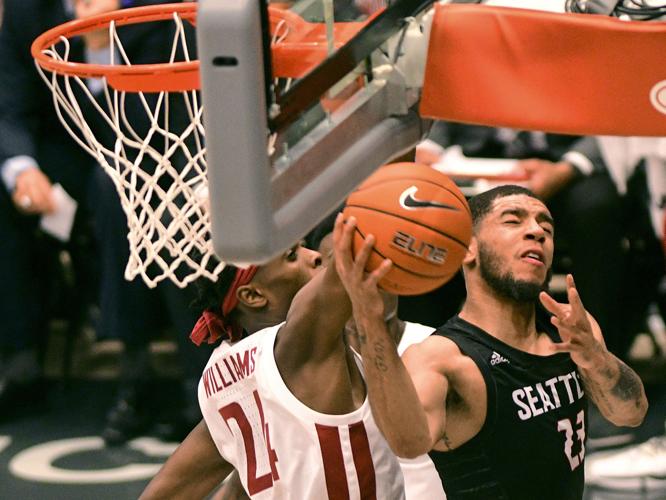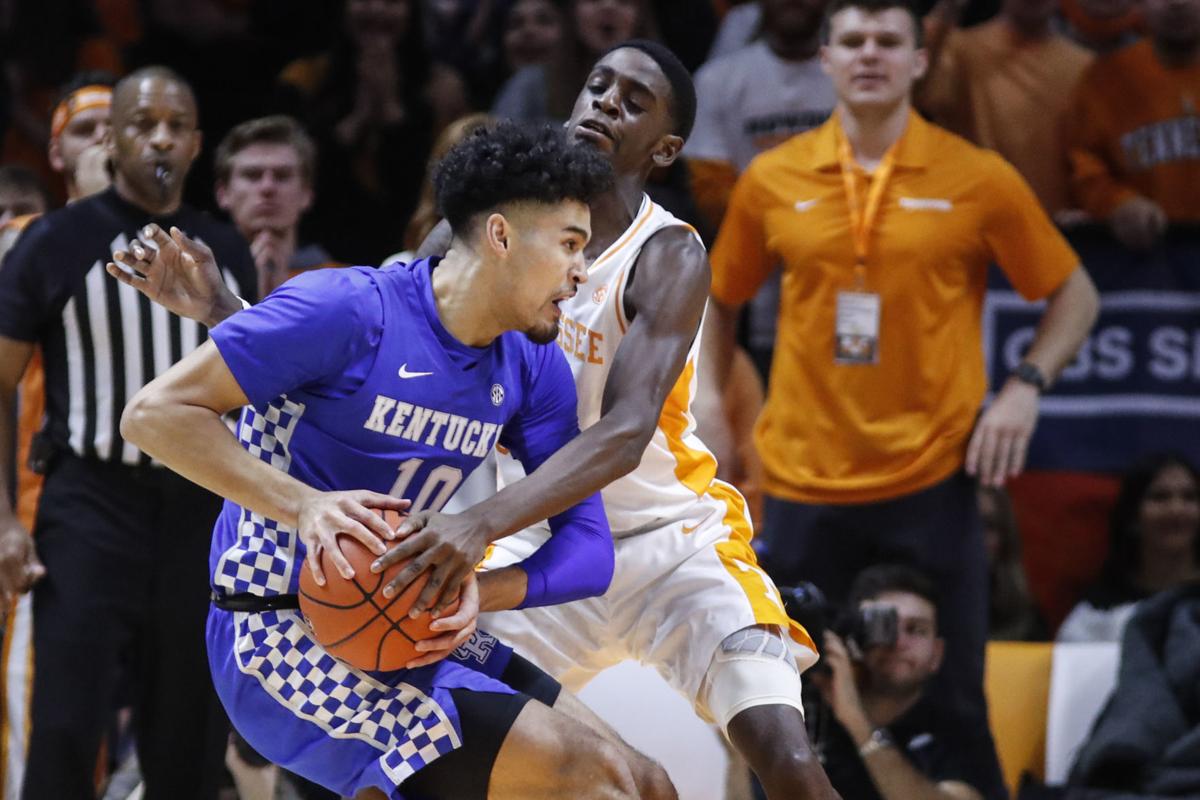On Monday, just four days after announcing he might leave Seattle University as a grad transfer — and only one day after Arizona coach Sean Miller swooped virtually into his living room — Terrell Brown committed to the Wildcats.
On Thursday, just 10 days after listing Arizona among six finalists, Kentucky transfer Johnny Juzang went ahead and picked UCLA.
They were just the latest two examples of how the coronavirus is speeding up transfers this spring, in some cases pushing them closer to home or to programs where they have a pre-established relationship.
Brown, the newest Wildcat, is a godson of former Arizona star Jason Terry. Juzang is from Los Angeles.
“I’m coming home!” Juzang tweeted, adding a note that included: “With this current pandemic, I think being close to home and close to family and friends is so important.”
Utah Valley wing Isaiah White committed to USC just six days after his club coach said UA and USC were recruiting him. And just 12 days after guard Erik Stevenson became one of five Wichita State players to announce a transfer on March 13, he picked home-state team Washington.
All in-person contacts are forbidden under a NCAA dead period that has already been extended from April 15 to May 31 because of the coronavirus.
That means players wanting to decide in the normal spring timeframe are prohibited from touring campuses and can’t open their homes to coaches,.As a result, everybody has plenty of time to cram in phone calls and video chats.
On top of that, there’s the usual squeeze coaches can put on recruits — telling them they have only one spot available for multiple targets, so committing first can guarantee they get one of them.
So, in essence, there is a lot of time… and not a lot of time that’s needed.

New Wildcat Terrell Brown, right, is the godson of Arizona legend Jason Terry. He averaged more than 20 points per game last season at Seattle.
“I think it’s speeding things up because there’s only so much you can learn over the phone and there’s only so much that’s going to change,” says Josh Gershon, a 247Sports.com recruiting analyst.
“There’s a realization that visits aren’t happening and schools aren’t opening up anytime soon. People have the information in front of them pretty quickly, and they’re making quick decisions.”
While UA associate head coach Jack Murphy could not address Brown or other UA recruiting targets because of NCAA rules, he said that the trend is more accelerated for transfers than high school players. Some high school players appear to be waiting for the best possible fit, sometimes to see if a school’s players leave for the NBA.
Among UA’s remaining 2020 high school targets are Minnesota guard Kerwin Walton and Los Angeles wing Ziaire Williams, neither of whom has announced plans to decide by the opening of the spring signing period next Wednesday.
While they wait, the Wildcats are keeping up with their fast-moving transfer targets. They gave a virtual presentation to San Francisco grad transfer Charles Minlend on Wednesday, according to Stockrisers, and the second-team all-West Coast Conference wing is expected to make a decision within two weeks.
Even Purdue big man Matt Haarms, who has been contacted by dozens of schools, is expected to whittle his list down shortly (Arizona’s chances of making his short list appear strong because of its available playing time and/or the fact that assistant Danny Peters grew to know Haarms when recruiting him as a Ball State assistant).
“With the dead period having been extended all the way to May 31, there’s no reason not to make a decision,” Murphy said. “You’re able to take these virtual tours, multiple times throughout a day, you can talk to different schools and different staffs, and the process just speeds up.
“And when you look around the landscape and see all these other guys making decisions in a short amount of time, I think it puts pressure on everyone to kind of make quicker decisions. I think you’re seeing that more and more with both grad transfers and four-year transfers.”
A few other things might have factored into Brown’s decision to pick Arizona. Not only was there the influence of Terry, who was a UA senior when Murphy was a freshman manager, but the Wildcats were also recruiting UNLV guard Amauri Hardy as a grad transfer and appeared unlikely to need both Hardy and Brown.
Then there was the PowerPoint presentation that Arizona gave him over the phone on Sunday morning.
“I think it’s been straight,” Brown said of UA’s approach. “The PowerPoint kind of showed me what the school is about, and I’m more of a person that where school still matters. I was talking to one of my old head coaches today and he said ‘I’m really proud of you because you’ll be transferring as a grad transfer.’”
For that reason, Brown said, he was impressed with mention of the CATS Forever program, which can offer financial and other assistance for UA athletes who return to finish their degrees, among other things.
“The PowerPoint was even showing the campus lifestyle, learning about Coach Miller and stuff like that,” Brown said. “And you can’t go against somebody who’s being genuine to you. They don’t want you to fail.”
Speaking in general about UA’s approach, Murphy said the PowerPoints are similar to the ones Miller will use during in-home visits with recruits. Now, they are emailed first, and a phone call is scheduled to go over it with the recruit and his family while everybody calls up the slides simultaneously.
Among the foremost topics of the PowerPoint, of course, is actual basketball.
“We talk about total development and give them some past comparisons to past players here,” Murphy said. “We’re not going to show a 7-foot center how he compares to T.J. McConnell. But we might show a four-year (guard) transfer how he’d compare to T.J. or we might show him how he’d compare for (former juco transfer guard) Kadeem Allen.
“So it’s situation: Are you a transfer? Are you a high school player? Are you international? And then it’s position (that a recruit plays). We tailor it to those aspects.”
Other topics can be customized, too.
For example, Murphy said a player expressing an interest in business will be shown slides on the Eller College of Management and who has attended it. UA staffers will also show how a particular player’s physical strengths can be improved, mentioning the long relationship between strength coach Chris Rounds and athletic trainer Justin Kokoskie, who also focuses on nutritional health.
“We have a lot of synergy there with the training room and the weight room,” Murphy said. “We talk about our academic programs and just try to encapsulate the program in general.”
Arizona supplements its presentations by sending UA-produced videos of its facilities and campus. And like many other coaches have been doing – at least those whose campus is not closed off entirely – Arizona staffers have also been ‘walking’ unfamiliar recruits through campus via individual FaceTime video calls.
That usually means Murphy or fellow staffers Danny Peters and David Miller will literally hold a phone up while walking around to show recruits how close the athletes’ Ginny Clements Academic Center is (across the street from McKale) or how close the Richard Jefferson practice gym is (adjacent to McKale).
Naturally, a lot of FaceTime occurs inside McKale itself.
“When you’re walking into McKale, you’re walking down this hallway with all our draft picks from 1988 — this is a powerful hallway, and you take your time going through it,” Murphy said. “Then you show them the office. You show them McKale Center, our locker room. And as you’re walking through it’s ‘Hey this is the path you would take from academics to the training room,’ or ‘If you’re walking from our locker room to the R.J. (practice gym), this is what it feels like.’
“Because they ask: ‘How far is the practice facility? Do I have to go across campus to meet with an academic advisor?’ No, it’s all here.”
Murphy said the PowerPoint presentations typically take about an hour. Recruits and their family members are welcome to ask questions throughout.
“In the last few that we’ve done, I think we’ve got it down pretty well to where at the end we ask if they have questions,” Murphy says, “and they say ‘A lot of our questions were answered during that presentation,’ which is always good to hear.”
It’s a condensed process that, at least in Brown’s case, was followed soon after by the words UA coaches want to hear most: That they will become Wildcats.






